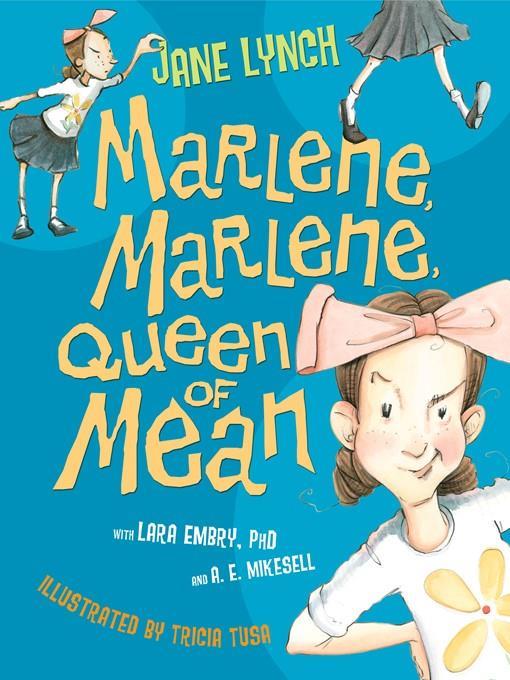
Marlene, Marlene, Queen of Mean
فرمت کتاب
ebook
تاریخ انتشار
2014
Lexile Score
850
Reading Level
2-5
ATOS
4
Interest Level
K-3(LG)
نویسنده
Tricia Tusaشابک
9780375982323
کتاب های مرتبط
- اطلاعات
- نقد و بررسی
- دیدگاه کاربران
نقد و بررسی

August 4, 2014
Glee star Lynch teams up with Embry,
a clinical psychologist who is her former spouse, and writer Mikesell for a story about the turnaround of a mean girl. Though the tale’s verse doesn’t always shine (“She’d stand on a chair/ to gloom and to glare,/ making everyone feel really tense”), it has other virtues. Instead of an adult savior, a fellow student named Big Freddy figures out how Marlene’s bullying works: “We cringe and we cower/ and give her our power/ because we all think/ she’s in charge!” United in peaceful resistance, the kids call Marlene’s bluff. And even after her reform, Marlene doesn’t transform overnight: “Her kindness can slide/ and her tone can be snide/ because her change is so recent.” Tusa (It’s Monday, Mrs. Jolly Bones) makes Marlene’s huge pink hair bow a comic symbol of her malice. It sails provocatively above her head as she stares down a group of children, droops as she realizes her classmates are on to her, then wilts altogether. A discussion opener that provides those at the mercy of bullies with a new perspective on their adversaries. Ages 3–7.

August 15, 2014
A heartfelt, albeit heavy-handed, treatise against bullying is delivered in plodding rhyming verse. Co-authored by Lynch (who, as Sue Sylvester on television's Glee, is a notorious bully), the rhyming text suffers under the weight of its earnest message and slim characterization. Why is Marlene so mean? Readers don't ever find out-apart from an oblique reference to anger that motivates her random acts of cruelty. Other children cower in her wake, while adults who might step in are pointedly absent from words and pictures. Finally, Big Freddy, "his voice loud and steady," intervenes to stop all the mean. He does so by simply asking Marlene why she is so mean and by pointing out to the others that she is not so scary after all. The children are emboldened by his actions, and they stand up to her too, refusing to flinch when she continues her tirade of bullying. In an odd narrative twist, she ends up sneezing out her meanness and deciding to reform, though the text eagerly points out that she doesn't become an angel overnight. Tusa's comical, lively, watercolor illustrations save the day in what would otherwise be a fairly forgettable addition to the anti-bullying bandwagon. With its heart on its sleeve, this offering falls short of other, better picture books that come out swinging against bullying. (Picture book. 4-6)
COPYRIGHT(2014) Kirkus Reviews, ALL RIGHTS RESERVED.

October 1, 2014
PreS-Gr 2-In this debut into the world of children's picture books, actress and comedian Lynch takes on school bullying. Marlene is intimidating. With her menacing stares, cruel pranks, and habit of pinching and kicking, she has become "queen of the scene." All the kids are afraid of her, until one day, astute Big Freddy asks, "Why?" He tells the playground of kids, "We cringe and we cower and give her our power because we all think that she's in charge!" When he tells Marlene that she is "just a bully," it is all that is needed to break her meanness into "123 pieces." When readers meet a reformed Marlene, she is learning to make friends, and though she's not intimidating anymore, she is still true to her nature and prone to the occasional prank. Tusa's signature watercolor pastel hues and cartoonlike pencil outlines offer a comic lightness and softness to a serious subject. Though the intended audience might not be familiar with Lynch's role as the bully Sue Sylvester on the television show Glee, this is an above-average celebrity picture book whose rhythm and rhyme scheme make for a fantastic read-aloud. It can also serve to open a discussion about bullying. Though similar in message, plot, and rhyme to Alexis O'Neill's The Recess Queen (Scholastic, 2002), libraries and classrooms cannot have too many books that explore the different ways children can be mean and what the bullied can do to stand up for themselves and others.-Danielle Jones, Multnomah County Library, OR
Copyright 2014 School Library Journal, LLC Used with permission.

























دیدگاه کاربران